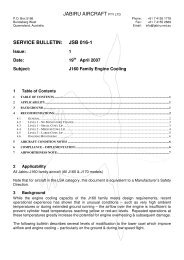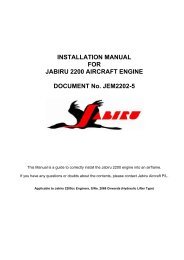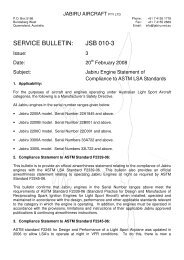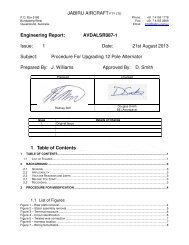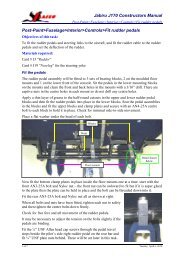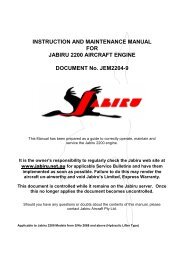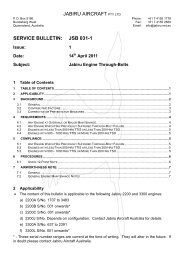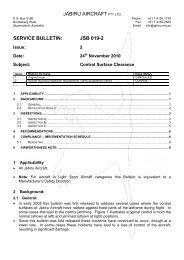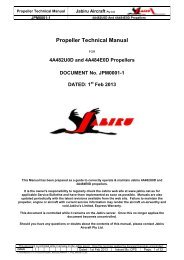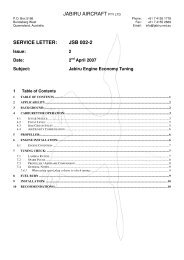JSL 007-4 - Jabiru
JSL 007-4 - Jabiru
JSL 007-4 - Jabiru
Create successful ePaper yourself
Turn your PDF publications into a flip-book with our unique Google optimized e-Paper software.
JABIRU AIRCRAFT PTY LTDP.O. Box 5792 Phone: +61 7 4155 1778Bundaberg West Fax: +61 7 4155 2669Queensland, Australia. Email: info@jabiru.net.auSERVICE LETTER: <strong>JSL</strong> <strong>007</strong>-4Issue: 4Date: 6 th Dec 2011Subject:Alcohol, Lead, Compression Ratio: Fuel GuidanceIssue Reason for Issue Revision Status1 Original Issue CANCELLED2 New Information Added CANCELLED3 Title changed, “High Lead” Avgas notes added CANCELLED4 New gasoline information added, UL9 1 approval added. CURRENT1 APPLICABILITY .................................................................................................................................................. 12 BACKGROUND ................................................................................................................................................... 13 GASOLINE GENERAL INFORMATION. ............................................................................................................ 24 ALCOHOL ........................................................................................................................................................... 45 GASOLINE CONTAINING TETRAETHYL-LEAD (TEL) .................................................................................... 86 AVGAS CONTAINING TEL ................................................................................................................................. 97 UNLEADED AVIATION GASOLINE (AVGAS) ................................................................................................... 98 MOGAS .............................................................................................................................................................. 109 FUEL SUMMARY .............................................................................................................................................. 1210 COMPRESSION RATIO / COMBUSTION CHAMBER SHAPE ....................................................................... 1311 CONTACT INFORMATION: .............................................................................................................................. 151 ApplicabilityAll <strong>Jabiru</strong> Aircraft and Engines.2 Background2.1 Issue NotesIssue 1 of this Service Letter was intended to provide operators with basic guidanceinformation for operating their aircraft and engines on fuels containing alcohol.Issue 2 was produced to include additional information about the combustion chamber,compression ratio and suitable fuels.Issue 3 added information for operators using fuels with a higher lead content. At thesame time, the technical content of the letter had moved so far beyond alcohol limits thatthe title of the Service Letter was changed to better reflect its content.Issue 4 is now CURRENT and has been prepared with additional information andoperating guidance to reflect recent trends in fuels and operating patterns. Issues 1 to 3 ofthis letter are now CANCELLED and must not be referenced.
<strong>Jabiru</strong> Service Letter: Alcohol, Lead, Compression Ratio: Fuel Guidance<strong>JSL</strong> <strong>007</strong>-4 6th Dec 20112.2 GeneralCurrent <strong>Jabiru</strong> 2200 and 3300 engines are designed to use Australian Aviation Gasoline(AVGAS), unleaded AVGAS or Australian Premium Unleaded Motor Spirit – MOGAS – ofat least 95 RON.The following letter has been prepared to allow operators to learn more about what is indifferent fuels and which are best suited to their particular engine. It providesrecommendations for using and storing different fuels.<strong>Jabiru</strong> Aircraft may choose to void any warranty for aircraft or engines which havebeen operated outside of the recommendations contained in this letter.3 Gasoline General Information.The following information can be heavy going but this fundamental knowledge will allowoperators to better understand how to operate and care for their engines.Modern fuels are an increasingly specialised field as each gasoline blend incorporatesingredients from diverse sources. Traditional gasoline refined from crude oil isincreasingly being blended with hydrocarbons from different sources – coal syngas, oilsands, shale oil, alcohols, algal and plant refineries to name a few. As with anycomplicated field some basic knowledge of the basic “rules of the road” are essential tooperate successfully.3.1 Fuel Basics:Gasoline, technically is a “Refined petroleum used as fuel for internal combustion engines”– petroleum being “A liquid mixture of hydrocarbons that is present in certain rock strataand can be extracted and refined to produce fuels including gasoline, kerosene, and dieseloil”. So under these definitions any liquid containing carbon and hydrogen, refined fromcrude oil, can be a gasoline. Obviously this is a very broad definition and which includesmany, many different chemical compounds.When burning a fuel in a piston engine one of the most important characteristics of the fuelis how much load it can take without “knocking”. Knock is a complicated mechanismwhich is also known as pinging or detonation; pre-ignition is a similar and related issue.The important thing to know is that knock – by whatever name – is bad news for a pistonengine. It causes excess temperature and pressure in the engine and in extreme casescan break pistons or cause other damage very quickly.An automotive fuel’s anti-knock performance is usually measured in Australia using RON(Research Octane Number). RON describes how early a fuel will start to knock – thehigher the RON the less susceptible the fuel is to knock. The same is also true for theother knock ratings discussed below: higher numbers indicate a fuel less likely to knock.The RON for a fuel is obtained by running the fuel in a special calibrated engine understrictly controlled conditions. The fuel being tested is compared to a special fuel made byblending iso-octane with heptane. Iso-octane has a RON value of 100 while helptane hasa value of 0. A 90 octane RON fuel is a fuel which behaves the same as a mixture of 90%iso-octane and 10% heptane. If the test fuel behaves the same way as a mixture of 90%iso-octane & 10% heptane it will be given a RON of 90. RON is a good performanceindicator for a fuel but it has some important limitations – mainly that the testing method isnot particularly realistic when compared with real world conditions.A MON is calculated using a similar test to RON but in this case the temperature of theintake mixture to the test engine is increased and ignition timing is altered. This is a betterreal-world indication of how a fuel will behave when under load in service – which is why<strong>JSL</strong><strong>007</strong>-4_Fuel_Guidance.docx Page 2 of 16
<strong>Jabiru</strong> Service Letter: Alcohol, Lead, Compression Ratio: Fuel Guidance<strong>JSL</strong> <strong>007</strong>-4 6th Dec 2011AVGAS octane ratings are given in MON. Actually, MON is also sometimes known as theAviation Lean Octane Rating as the test was invented with high-powered aircraft enginesin mind. Again however, the MON is a controlled test and does not completely reflect howa fuel will perform in the real world.AKI (Anti-Knock Index) is also commonly used in some countries. AKI is the average of afuel’s RON and MON. RON is always a higher number than both MON and AKI. As ageneral rule, RON can be estimated by adding 5 to a fuel’s AKI (i.e. a fuel with an AKI of89 will have a RON of approximately 94, and so must not be used.). AVGAS 100LL generally has a MON (lean) of around 100-101. Depending on thecomposition of the fuel, the MON of a modern gasoline will be about 8 to 10 points lowerthan the RON, however there is no direct link between RON and MON. Using thisestimation AVGAS 100LL would have a RON of about 110.Octane ratings are not a direct measure of how “powerful” a fuel is. A fuel with a higheroctane number will not usually produce more power in a given engine unless that engine ismechanically altered to take advantage of the fuel. However, a higher octane numbershould – all else being equal – allow an engine to safely operate under higher loads at alower RPM.Additional details, including a useful table which shows the RON, MON and AKI ratings forvarious fuels are available online at http://en.wikipedia.org/wiki/Octane_rating .3.2 Fuels In Service:All of the Octane tests described above are carried out under controlled conditions oftemperature, RPM etc. Obviously in service these conditions are not controlled –temperatures, engine loads, rpm etc all vary. To try to cater for all these variations thehydrocarbon blend of a given fuel is constantly being adjusted by the fuel supplier. SoBrand X 95 Octane (RON) gasoline purchased in a hot, arid area will contain a differentchemical blend to the same fuel bought in a cool, low-altitude area. Both fuels have thesame RON but their composition can be very different and taken away from theenvironment they were designed for they may not perform the same. In comparison,AVGAS is blended for use in aircraft engines which operate using relatively crude mixturecontrol and widely varying conditions of engine load, RPM, temperature, altitude etc.It is important to realise that having the same RON, MON, AKI etc does not makedifferent fuels the same or even compatible.Modern cars use computer controls to ensure that the engine operates as it should on anygiven fuel. Any engine which uses a carburettor (or similar) does not have this level ofcontrol and is potentially more vulnerable to changes in fuel blends.3.3 ShandiesA “shandy” is a mix - for the purposes of this letter it is a mix of any 2 or more differentfuels.In some areas it has become popular to operate <strong>Jabiru</strong> engines on a shandy of AVGASand MOGAS. This might be done to reduce the cost of fuel, to reduce lead buildup in thecombustion chamber, to “beef up” the octane rating of a sub-standard fuel or otherreasons.This practice is unsafe. <strong>Jabiru</strong> Aircraft do not endorse it and may void any warrantyof an engine or aircraft which has been operated using such a fuel.In terms of chemical composition AVGAS is totally different to MOGAS. A petroleumcompany representative described mixing the two as similar to “mixing Gin with Beer”.<strong>JSL</strong><strong>007</strong>-4_Fuel_Guidance.docx Page 3 of 16
<strong>Jabiru</strong> Service Letter: Alcohol, Lead, Compression Ratio: Fuel Guidance<strong>JSL</strong> <strong>007</strong>-4 6th Dec 2011Hardcore cocktail fans aside, mixing these drinks is a bad idea – it tastes bad and the afteraffects can be messy & expensive. There is potential for elements in the fuels to react toeach other and the finished blend would have unknown knock resistance – because thefuels are so complex you cannot assume that mixing 110 RON AVGAS with 91 RONMOGAS – at almost any mixing proportion – will result in a fuel with acceptable knockresistance for a <strong>Jabiru</strong> aero engine.4 Alcohol4.1 GeneralWorldwide, debate on using Ethanol as an aircraft fuel continues. The problem is that whileit can be a good fuel for the engine, it is a significant operational, maintenance and storageissue for the rest of the aircraft. These issues must be addressed if an aircraft is to operatesafely on a fuel containing alcohol.Note that different <strong>Jabiru</strong> Airframes can have different maintenance requirements. Forexample, the CASA-Certified J160-C must be operated and maintained in accordance withthe CASA-Approved procedures given in its Flight and Maintenance manuals – which donot allow the use of fuels containing alcohol (but do approve the use of suitable MOGAS).Operators using Octane Boosters and wishing to avoid introducing alcohol to their fuelsystems must ensure that their chosen octane booster does not contain alcohol. <strong>Jabiru</strong>Aircraft recommend avoiding the use of octane boosters.4.2 Alcohol – Good PointsAlcohol is a renewable fuel which (arguably) produces less carbon dioxide than fossil fuel.Alcohol burns cleanly and has an octane boosting effect.4.3 Alcohol – Bad PointsEthanol is hygroscopic (i.e. it will mix with water). This can be water vapour from the air,condensation inside tanks or free water. While very small amounts of water can beabsorbed without significantly affecting combustion, at higher levels the mixture will not becombustible. In addition, because this incombustible fuel is formed from a mixture of theEthanol in the fuel and the water it can have a large volume – so a small amount of waterwill result in a much larger amount of incombustible Ethanol/water mix. This may give falsereadings in the fuel tank sumps or exceed the volume of the sump altogether.As noted above, Ethanol is an Octane booster and can be absorbed by water. Because ofthis, mixing a fuel with water can effectively wash the Ethanol out of the fuel resulting in asignificant drop to the remaining fuel’s Octane rating.If an Octane Booster containing alcohol is used the operator must ensure that the maximumalcohol content of the resulting fuel / booster mix does not exceed the limits given below.Due to the fact that their composition varies widely between brands <strong>Jabiru</strong> Aircraftrecommend avoiding the use of octane boosters.The engine will use slightly more fuel as the percentage of added alcohol increases. As anapproximate rule of thumb the engine must burn 3% more fuel to give the same poweroutput if the fuel contains 10% Ethanol.Ethanol mixed with water is somewhat corrosive and may attack parts of the fuel system.In long-term storage, Ethanol may oxidise with exposure to air. This process produces amild acid solution (effectively vinegar – the effect is the same as when the seal fails on abottle of wine) which can attack fuel system components.<strong>JSL</strong><strong>007</strong>-4_Fuel_Guidance.docx Page 4 of 16
<strong>Jabiru</strong> Service Letter: Alcohol, Lead, Compression Ratio: Fuel Guidance<strong>JSL</strong> <strong>007</strong>-4 6th Dec 2011Long term exposure to Ethanol damages some types of plastics. The flexible fuel linesused by <strong>Jabiru</strong> Aircraft have been chosen with Ethanol use in mind and are designed to besafe when replaced at the intervals specified in the aircraft Maintenance Manuals. Howeverincreased monitoring during servicing is recommended when using an Ethanol blend.Note that flexible fuel lines are available in a wide range of colours. Generally the colour ofthe line is a dye only and has no bearing on the line’s ability to operate in contact withalcohol – though some fuel line manufacturers use different colours to designate differentproducts. <strong>Jabiru</strong> Aircraft have used blue fuel lines and (at the time of writing) orange lines.Both are acceptable for use with fuels containing alcohol.Some fuel testers (including the type supplied by <strong>Jabiru</strong> Aircraft at the time of writing) havea scale on their side which allows the Ethanol content of a fuel to be checked & assessed.Several Australian Civil Aviation Safety Authority (CASA) documents discuss Ethanol use inaircraft. <strong>Jabiru</strong> Aircraft strongly recommend that owners considering using an Ethanol fuelblend read and understand this information before using a fuel of this type. The followingCASA document is current at the time of writing: Airworthiness Bulletin AWB 2828-003003Important Note For <strong>Jabiru</strong> Aircraft: Only aircraft with white coloured fuel tank sealant canuse fuel containing alcohol. Earlier tanks use a caramel coloured sealant – this sealant issoluble in alcohol & must not be used with an alcohol blend fuel. Fuel tanks with caramelcolouredsealant may be re-sealed with white sealant – contact <strong>Jabiru</strong> Aircraft or our localrepresentative for details. Figure 1 shows the sealant colour as seen through the filler.4.4 Individual Items 1 :Figure 1 – Fuel Tank Sealant Colours (White on Left) Carburettor: Suitable for use with fuels containing alcohol. Carburettor inspection recommended after 200hrs (or 6 months) using fuel containing alcohol Mechanical Fuel Pump: Suitable for use with fuels containing alcohol. No additional maintenance required for up to 10% alcohol The pump manufacturer does not recommended using fuels containing more than 10%. Operational experience with fuels containing higher percentages has shown that themechanical fuel pump is tolerant of higher levels of alcohol. Carburettor Connection: Suitable for use with fuels containing alcohol.1 Details applicable for OEM parts from <strong>Jabiru</strong> Aircraft Australia only<strong>JSL</strong><strong>007</strong>-4_Fuel_Guidance.docx Page 5 of 16
<strong>Jabiru</strong> Service Letter: Alcohol, Lead, Compression Ratio: Fuel Guidance<strong>JSL</strong> <strong>007</strong>-4 6th Dec 2011 Electronic Fuel Pump: Suitable for use with fuels containing alcohol. O-Rings: Suitable for use with fuels containing alcohol. Black Fuel Hose: Suitable for use with fuels containing alcohol. Blue Fuel Hose: Suitable for use with fuels containing alcohol. Maintenance & inspection requirements increased for fuel containing more than 10% alcohol. White Coloured Fuel Tank Sealant: Suitable for use with fuels containing alcohol. Caramel Coloured Fuel Tank Sealant: Unsuitable for use with fuels containing alcohol. Combustion Chamber Shape: All combustion chamber shapes are compatible with fuelscontaining alcohol. However, the Octane rating of the fuel used must be selected to suit thecombustion chamber design.4.5 Testing for AlcoholUsing a clear jar of about 100-200 ml capacity (ideally a long and narrow jar) add about10% by volume of water and mark the level of the water on the jar. Add a sample of the fuel to be tested to the jar so that the relative volumes are about 10%water/90% fuelShake the sample vigorously and then allow the sample to settleCheck the level of the “water”If the level is the same as previously marked on the jar, no alcohol is present in the fuel.If the level of “water” increases, alcohol is present in the fuel4.6 Alcohol Usage Recommendations4.6.1 General: Where possible <strong>Jabiru</strong> Aircraft recommend using AVGAS. This is a fuel specificallydesigned for aircraft use and is subject to very strict documentation and quality assurance.This is simply the safest fuel available.Because it has a higher compression ratio the <strong>Jabiru</strong> 5100 engine must be operated usingAVGAS or other fuel with a RON of 100 or higher.Where a <strong>Jabiru</strong> Engine is installed in a non-<strong>Jabiru</strong> airframe the operator must comply withthe airframe manufacturer’s approved fuel recommendations.4.6.2 Use of Gasoline Containing Up to 10% Alcohol:<strong>Jabiru</strong> Aircraft has no objection to operators using gasoline containing up to 10% alcohol in<strong>Jabiru</strong> Aircraft or <strong>Jabiru</strong> Engines except as limited by the aircraft’s certification basis. Formost engines the use of fuel with RON of 95 or above is adequate, however older enginesmust use a fuel which meets the Octane rating requirements of their combustion chamber(See Section 10 above).Only those <strong>Jabiru</strong> Aircraft with white coloured fuel tank sealant can use fuelcontaining alcohol.No modifications are required for <strong>Jabiru</strong> Engines to use fuel containing 10% alcohol.Where a <strong>Jabiru</strong> Engine is installed in a non-<strong>Jabiru</strong> airframe the operator must comply withthe airframe manufacturer’s approved fuel recommendations.Fuel hose should be monitored for hardness, brittleness and loss of colour. Lines must beinspected regularly and renewed if any sign of deterioration (such as brittleness orcracking) is found. In addition, at the time of writing <strong>Jabiru</strong> Aircraft recommend that all<strong>JSL</strong><strong>007</strong>-4_Fuel_Guidance.docx Page 6 of 16
<strong>Jabiru</strong> Service Letter: Alcohol, Lead, Compression Ratio: Fuel Guidance<strong>JSL</strong> <strong>007</strong>-4 6th Dec 2011flexible fuel lines be replaced at intervals (see the aircraft Technical Manual). While thismaintenance system is considered adequate while using a fuel containing alcohol,operators choosing to use these fuels are encouraged to be especially pro-active andexacting in their fuel system maintenance.It is recommended that after the first 200hrs (or 6 months) of operation on fuel containingalcohol the carburettor be disassembled for a one-off inspection. Components must bechecked for damage, i.e. excessively soft or hard rubber parts, swelling of rubbercomponents, corrosion of metal components. Replace parts if damaged or in doubt.4.6.3 Use of Gasoline Containing Between 10% and 20% Alcohol: <strong>Jabiru</strong> Aircraft does not recommend that operators use any fuel containing between 10%and 20% alcohol in <strong>Jabiru</strong> Aircraft or <strong>Jabiru</strong> Engines.Operational experience has shown that operating <strong>Jabiru</strong> Aircraft and Engines with a fuelcontaining 10% – 20% alcohol is safe and does not introduce excessive maintenancerequirements. However, formal testing has not been carried out and this level of alcoholcontent exceeds the maximum safe recommendations for some fuel system components.Operators using such fuel must understand that they operate entirely at their own risk.Clearly such operations can only occur in categories such as the “Experimental” categorywhere all aircraft occupants & operators fly at their own risk.Only those <strong>Jabiru</strong> Aircraft with white coloured fuel tank sealant can use fuelcontaining alcohol.No modifications are required for <strong>Jabiru</strong> Engines run using fuel with 10% - 20% alcohol.Where a <strong>Jabiru</strong> Engine is installed in a non-<strong>Jabiru</strong> airframe the operator must comply withthe airframe manufacturer’s approved fuel recommendations.The ongoing maintenance requirements of a <strong>Jabiru</strong> aircraft or engine using this level ofalcohol are currently unknown. The following points are recommended, however they areintended as a basic guide for operators and may not address all issues found whenoperating on these fuels. Operators must develop their own ongoing maintenance andinspection scheme suitable to their fuel and usage.i. Fuel hose should be monitored for hardness, brittleness and loss of colour. Linesmust be inspected regularly and renewed if any sign of deterioration (such asbrittleness or cracking) is found. It is recommended that all flexible fuel lines bereplaced at 1 year intervals when using fuels containing 10% – 20% alcohol.ii. At every 200hrs (or 6 months) of operation the carburettor be disassembled & allcomponents checked for damage, i.e. excessively soft or hard rubber parts, swelling ofrubber components, corrosion of metal components. Replace if damaged or in doubt.iii. At every 200 hours (or 6 months) of operation the mechanical fuel pump bedisassembled and all components checked for damage, i.e. excessively soft or hardrubber parts, swelling of rubber components, corrosion of metal components. Replacecomponent if damaged or in doubt.4.6.4 Use of Gasoline Containing More Than 20% AlcoholUse of fuel containing more than 20% alcohol is not recommended.4.7 Checks When Changing to a Fuel Containing AlcoholFuel filter & carby bowl - check for sediment & clogging after 10 hrs (or 1 month) of use.It is recommended that fuel lines be renewed before switching to a fuel containing alcohol.<strong>JSL</strong><strong>007</strong>-4_Fuel_Guidance.docx Page 7 of 16
<strong>Jabiru</strong> Service Letter: Alcohol, Lead, Compression Ratio: Fuel Guidance<strong>JSL</strong> <strong>007</strong>-4 6th Dec 20115 Gasoline Containing Tetraethyl-Lead (TEL)5.1 GeneralIn most countries worldwide AVGAS is the only gasoline available which still contains TEL.Of the AVGAS family, AVGAS 100LL is the most common grade available. The “LL”designation indicates that the fuel contains a “Low Lead” level when compared to AVGAS100 (which may also be known as AVGAS 100/130). AVGAS 100LL contains less than0.56grams/litre while AVGAS 100 contains less than 0.85g/L. AVGAS 100LL is dyed bluewhile AVGAS 100 is dyed green. To complicate things, in some countries MOGAScontaining TEL is also available which contains more lead than even AVGAS 100/130.5.2 Tetraethyl Lead – Good PointsTEL is an additive which is traditionally included in fuels to help suppress knock. Knockproduces very high pressures inside the engine which can easily cause severe damage.Aircraft engines are particularly vulnerable to knock because they operate at higher powersettings and temperatures than most other types of engine – this is one reason whyAVGAS still contains TEL.TEL has some lubrication properties which help to reduce wear to valve guides etc.5.3 Tetraethyl Lead – Bad PointsLead is a well known pollutant.TEL in a fuel produces combustion chamber deposits. These deposits can affect pistonring sealing, valve sealing and also inhibit heat transfer from the combustion chamber tothe head. They can also cause pre-ignition – small pieces can become very hot and actlike a glowing ember inside the combustion chamber. This “ember” then ignites the fuelbefore the spark plug has discharged. Modern, high-octane unleaded MOGAS burns very cleanly. It leaves no or minimaldeposits inside the combustion chamber. In comparison, a fuel containing TEL will leavedeposits approximately proportional to its lead content – i.e. higher lead equals moredeposits. Compared to AVGAS 100/130, AVGAS 100LL produces around 25% lesscombustion chamber deposits. This can significantly improve overhaul life in certainengines by reducing valve & cylinder head deposits as well as reduce spark plug fouling.There is however a maximum practical limit for the thickness of lead deposits inside acombustion chamber – they do not keep on growing thicker and thicker indefinitely. Thismeans that when using AVGAS 100 the deposits reach this thickness and then stabilisemore quickly than when using AVGAS 100LL.Lead can find its way into the oil of the engine where it tends to form a sludge whichimpedes the correct function of the lubrication and cooling system.5.4 Leaded Gasoline Usage Recommendations<strong>Jabiru</strong> Aircraft have no objection to operators using a fuel containing TEL.5.5 Leaded Gasoline Storage RecommendationsStore as indicated for AVGAS or MOGAS (whichever is appropriate to the fuel beingused).<strong>JSL</strong><strong>007</strong>-4_Fuel_Guidance.docx Page 8 of 16
<strong>Jabiru</strong> Service Letter: Alcohol, Lead, Compression Ratio: Fuel Guidance6 AVGAS Containing TEL6.1 AVGAS – Good Points<strong>JSL</strong> <strong>007</strong>-4 6th Dec 2011Excellent octane levels and knock resistance.AVGAS is readily available at airports in Australia and many other countries.AVGAS contains TEL which has some beneficial effects as discussed in Section 5. Thecombination of benefits given by TEL have proven to be hard to produce any other waywhich has made it difficult to develop a replacement fuel which will operate correctly inaircraft engines – particularly older types or high-powered turbo types.AVGAS has far superior quality control compared to MOGAS. Chemical composition isalso more tightly controlled.Alcohols are not used in traditional leaded AVGAS.As a rule AVGAS fares better in storage. Due the lower designed volatility it tends toevaporate less and be less reactive with air etc.6.2 AVGAS – Bad PointsLeaded AVGAS contains TEL which can cause operational issues due to combustionchamber deposits. Using a fuel containing TEL is also becoming more and moreenvironmentally unacceptable.AVGAS is more expensive than MOGAS.6.3 AVGAS Usage RecommendationsUse fuel which is as fresh as possible.Be aware of the potential maintenance issues arising from using a leaded AVGASFollow the storage recommendations given below.6.4 AVGAS Storage recommendations:Use fuel which is as fresh as possible.Avoid long term storage, especially in vented tanks.7 Unleaded Aviation Gasoline (AVGAS) In some countries unleaded AVGAS is becoming available. In particular, in Europe UL 91fuel is available.7.1 Unleaded AVGAS – Good PointsThese fuels must comply with AVGAS QA standards.MON of 91 (RON 96) is acceptable for <strong>Jabiru</strong> engines & is higher than most MOGAS.This type of fuel is becoming more available at many airports.No alcohol.No lead.Cleaner exhaust emissions.7.2 Unleaded AVGAS – Bad PointsLower octane ratings when compared with traditional AVGAS (though this is not an issuewith most <strong>Jabiru</strong> Engines).Availability poor in many countries<strong>JSL</strong><strong>007</strong>-4_Fuel_Guidance.docx Page 9 of 16
<strong>Jabiru</strong> Service Letter: Alcohol, Lead, Compression Ratio: Fuel Guidance<strong>JSL</strong> <strong>007</strong>-4 6th Dec 20117.3 Unleaded AVGAS – Usage Recommendations Use fuel which is as fresh as possible. Follow the storage recommendations given below.7.4 Unleaded AVGAS - Storage Use fuel which is as fresh as possible. Do not store for long periods of time, particularly in vented tanks.8 MOGAS8.1 MOGAS – Good PointsMOGAS is cheaper than AVGAS & more widely available – though not usually at airports.MOGAS burns cleanly & produces minimal combustion chamber deposits.Fresh MOGAS of the correct octane rating produces the same engine power as AVGAS.8.2 MOGAS – Bad PointsThe vast majority of MOGAS blends have lower octane ratings and therefore lessresistance to knock than AVGAS blends.The single biggest drawback with MOGAS is Quality Control – quality control for MOGASis very much poorer than for AVGAS. Fuel sold from automotive service stations cancontain a bigger range of components and may be stale, contaminated or diluted. Thebusiest service station in town is most likely to have fresh, clean fuel and getting to knowthe station operators is also a good idea.It is important to realise that due to the lower QA standards, even following bestpractice it is still possible for a particular tank-full of MOGAS to be unsuitable orunsafe for use in a <strong>Jabiru</strong> Aircraft or Engine. <strong>Jabiru</strong> Aircraft may choose to void anywarranty for aircraft or engines which have been damaged due to “bad” MOGAS.Operators use MOGAS at their own risk.Many automotive MOGAS blends rely on highly volatile components. During storage thesevolatiles can be lost rapidly and the fuel’s performance can degrade significantly in arelatively short period of time. This needs to be stressed to operators as it is entirelypossible for MOGAS loose several points from its Octane rating while stored, leaving theengine vulnerable to detonation. In addition, long-term storage of MOGAS in an openventedfuel system like a <strong>Jabiru</strong>’s can encourage the formation of gums, varnishes orsolids which can then block the lines or filters.Several different fuel blends are sold at the bowser throughout the year. “Winter” fuel,“Summer” fuel and “Alpine” fuel (and many other sub-divisions) are sold depending on thetime of year and the location of the fuel station. These fuels all have different recipesdesigned to provide the right vaporization, octane number etc for an engine operating inthe given environment. Fuel bought at the top of a snow-covered mountain in winter is notideal for use at sea level during a summer heat wave. This is another reason why longtermstorage of MOGAS is not recommended.Automotive fuels are generally more prone to vapour-lock than AVGAS. Testing hasshown that <strong>Jabiru</strong> Aircraft meet certification requirements for the prevention of vapour-lockwhen using MOGAS, however issues can be provoked by poor operational procedures.The following are recommended when operating on MOGAS:<strong>JSL</strong><strong>007</strong>-4_Fuel_Guidance.docx Page 10 of 16
<strong>Jabiru</strong> Service Letter: Alcohol, Lead, Compression Ratio: Fuel Guidance<strong>JSL</strong> <strong>007</strong>-4 6th Dec 2011i. Avoid running the engine for extended periods on the ground – this causes heat-soakinto the engine bay which increases vapour-lock risk.ii. Use the back-up electric fuel pump for all critical modes of flight – generally any time theaircraft is on the ground or within 1500 feet of the ground. <strong>Jabiru</strong> Aircraft have noobjection to operators running the electric boost pump continuously.8.3 MOGAS Usage RecommendationsDue to QA considerations, operators who use MOGAS do so at their own risk.Use fuel which is as fresh as possible.Be aware of the potential issues arising from using MOGASFollow the storage recommendations given below.Operators wishing to use automotive gasoline but wishing to avoid using alcohol shouldobtain Technical Data Sheets for the Gasoline they are using. Regular testing as detailedabove should also be carried out to ensure the fuel does not contain alcohol.8.4 MOGAS - StorageDue to the storage issues of MOGAS discussed above it is recommended that MOGAS isstored in the aircraft for no more than 1 month.Storage outside the aircraft depends on the ambient conditions, how the tank is ventedand many other factors. Again, due to the issues discussed above <strong>Jabiru</strong> recommend notusing any fuel which has been stored for 1 month or longer in anything other than industryapproved gasoline tanks. Drums, jerry cans and above-ground tanks are not consideredapproved tanks.If you drain the tanks, take care to also drain the MOGAS from the carburetor – otherwise,as the fuel evaporates from the carburettor it may form a varnish which will block jets etc.Do not block the tank vents to prevent evaporation: as the temperature around the aircraftrises and falls during the day and night the contents of the tank expand, contract and giveoff gases. If the vents are blocked these effects can easily rupture the tank.8.5 MOGAS Storage recommendations:Do not use MOGAS which has been stored for more than 1 month outside of an approvedgasoline storage tank in a <strong>Jabiru</strong> engine.Leave the tank and carburettor full of AVGAS orRun the carburettor dry by turning off the fuel tap and running the engine until it stops, thendrain all MOGAS from the tanks.Note that the storage methods currently outlined in <strong>Jabiru</strong> Technical Manuals generallypresume that the aircraft is being operated on AVGAS – which suffers far less from theproblems noted above.Commercial fuel additives and stabilizers are available which are designed to allowMOGAS to be stored for longer however <strong>Jabiru</strong> Aircraft have not tested their efficacy ortheir effects on other parts of the fuel system. <strong>Jabiru</strong> Aircraft does not currently endorse orapprove their use.<strong>JSL</strong><strong>007</strong>-4_Fuel_Guidance.docx Page 11 of 16
<strong>Jabiru</strong> Service Letter: Alcohol, Lead, Compression Ratio: Fuel Guidance<strong>JSL</strong> <strong>007</strong>-4 6th Dec 20119 Fuel Summary9.1 Approved Fuels Unleaded Aviation Gasoline (AVGAS) UL91 meeting ASTM D7547 AVGAS 100LL AVGAS 100/130 MOGAS with RON of 95 or higher and alcohol content as detailed in Section 4.9.2 Fuel Preference ChartThe Perfect Fuel (mythical beast – does not exist)The State of the Art (best fuel available for <strong>Jabiru</strong> Engines)Quite Suitable (A good fuel with some relatively minor negatives)Suitable (A good fuel but which has operational, maintenance and legal requirements theoperator must be aware of)Marginal. (Should only be used when the operator has no other suitable choice)UNSUITABLE for use with <strong>Jabiru</strong> Engines.AVGAS 100LLAVGAS 100Fuel Pro Con RatingAVGAS UL91(Unleaded AVGAS)Other AVGAS Blendswith Higher LeadLevels95+ Octane RONMOGAS- Availability (varies)- Quality assurance- Designed for aircraft.- Ease of storage- Availability (varies)- Quality assurance- Designed for aircraft.- Ease of storage- Availability (varies)- Quality Assurance- Designed for Aircraft- No Lead.- Availability (varies)- Quality assurance- Designed for aircraft.- Ease of storage- Availability (varies)- No lead- Price- Clean burn- Good Octane when fresh- Availability (varies)- Lead content- Price- Availability (varies)- Lead content- Price- Maintenance may be higher- Availability (varies) - Availability (varies)- Lead content- Price- Maintenance may be higher- Availability (varies)- Does not store well- Lower quality controls- Not designed for aircraft<strong>JSL</strong><strong>007</strong>-4_Fuel_Guidance.docx Page 12 of 16
<strong>Jabiru</strong> Service Letter: Alcohol, Lead, Compression Ratio: Fuel Guidance<strong>JSL</strong> <strong>007</strong>-4 6th Dec 201195+ Octane RONMOGAS ContainingAlcoholLower Octane Fuelswith Octane BoosterAdded- Availability (varies)- No lead- Price- Clean Burn- Good octane when fresh- Availability (varies)- Price- No lead- Clean burnLower Octane fuels - None Applicable- Availability (varies)- Does not store well- Lower quality controls- Extra alcohol-relatedmaintenance required.- Not designed for aircraft- Availability (varies)- Unknown octane rating- Lower quality controls- Does not store well- Unknown octane boostercontent- Extra alcohol-relatedmaintenance required.- Not designed for aircraft- Unsuitable- Will damage engines- May write engine offcompletely.10 Compression Ratio / Combustion Chamber Shape10.1 Compression RatioAt Manufacture the compression ratios of <strong>Jabiru</strong> Engines were as listed:- 1600 All S/No. 9.3:1- 2200 S/No. 1 – 106 9.3:1- 2200 S/No. 107 – 127 9.3:1- 2200 S/No. 128 – 831 7.8:1 or 8.3:1- 2200 S/No. 832 – 1003 7.8:1 or 8.3:1- 2200 S/No. 1004 Onwards 8:1- 3300 S/No. 1 – 223 7.8:1 or 8.3:1- 3300 S/No. 224 Onwards 8:1- 5100 All S/No. 8.5:1Where two ratios are listed those engines fitted with shims between the cylinder barrel andthe crankcase have the lower ratio, engines without shims the higher.Note that the details given above apply to each engine as it was produced. As many ofthe older engines are now more than 10 years old and have been overhauled in themeantime, operators must be aware that the engine’s current configuration may bedifferent from that given here.10.2 Combustion Chamber ShapeOlder <strong>Jabiru</strong> Engines had a combustion chamber shape which demands the use ofAVGAS or 100 Octane RON fuel. Details are given below.<strong>JSL</strong><strong>007</strong>-4_Fuel_Guidance.docx Page 13 of 16
<strong>Jabiru</strong> Service Letter: Alcohol, Lead, Compression Ratio: Fuel Guidance<strong>JSL</strong> <strong>007</strong>-4 6th Dec 2011Note that the details given above apply to each engine as it was produced. As many ofthe older engines are now more than 10 years old and have been overhauled in themeantime, operators must be aware that the engine’s current configuration may bedifferent from that given here. The following engines were manufactured with combustion chamber as shown in Figure 2.- 2200 S/No. 1 - 1003.- 3300 S/No. 1 - 223- All <strong>Jabiru</strong> 1600 engines.Figure 2 – Early “High Octane” Combustion Chamber The “High Octane” chamber can be modified as shown in Figure 3.Combustion chamberedges re-shapedFigure 3 – Re-Worked “High Octane” Combustion ChamberEngines with Serial Numbers higher than the range listed above were manufactured usingvariations of the combustion chamber shown in Figure 4.<strong>JSL</strong><strong>007</strong>-4_Fuel_Guidance.docx Page 14 of 16
<strong>Jabiru</strong> Service Letter: Alcohol, Lead, Compression Ratio: Fuel Guidance<strong>JSL</strong> <strong>007</strong>-4 6th Dec 2011Figure 4 – Current “Wedge” Combustion Chamber10.3 Fuel Octane Rating RequirementsAll 2200B, 2200C and 3300L engines may be operated using 95 Octane RON (or higher)MOGAS or AVGAS fuels. The fuels may contain alcohol to the limits listed in Section 4.6. Table 1 can be used to find which fuels should be used for a given engine. Example: 2200engine, S/No. 800 with no shims fitted and therefore compression ratio of 8.3:1.Combustion chambers have been re-worked to Figure 3. Read the table as marked withthe arrows, to the grey-shaded cell: the engine may use 95 Octane MOGAS.Table 1 – Chamber / Compression MatrixCompressionRatio:“High Octane”ChamberModified “HighOctane” Chamber“Wedge” Chamber9.3:1 100 RON or higher 100 RON or higher N/A8.5:1 N/A N/A 100 RON or higher8.3:1 100 RON or Higher 95 RON or higher N/A8:1 N/A N/A 95 RON or higher7.8:1 95 RON or Higher 95 RON or higher N/A Any of these engines may use fuels containing alcohol up to the limits given in Section 4.6.11 Contact Information:Preferred Method of Contact:Postal Address:email info@jabiru.net.au<strong>Jabiru</strong> Aircraft P/LPO Box 5186Bundaberg West, 4670QLD, Australia<strong>JSL</strong><strong>007</strong>-4_Fuel_Guidance.docx Page 15 of 16
JABIRU AIRCRAFT PTY LTDP.O. Box 5792 Phone: +61 7 4155 1778Bundaberg West Fax: +61 7 4155 2669Queensland, Australia. Email: info@jabiru.net.auSafety Directive: JSDL <strong>007</strong>-4Issue: 4Date: 6 th Dec 2011Subject:Alcohol, Lead, Compression Ratio: Fuel GuidanceApplicability: All <strong>Jabiru</strong> Aircraft & Engines operating in Light Sport Aircraft categoriesDetails: <strong>Jabiru</strong> Aircraft and Engines operating in Light Sport Categories may use fuels as detailedin <strong>Jabiru</strong> Service Letter <strong>JSL</strong><strong>007</strong>-4Background:This Safety Directive has been prepared to allow the application of <strong>JSL</strong><strong>007</strong>-4 to aircraftoperating within Light Sport Aircraft Categories.Page 1 of 1





